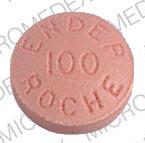Endep and Alcohol/Food Interactions
There are 2 alcohol/food/lifestyle interactions with Endep (amitriptyline).
Amitriptyline Alcohol (Ethanol)
Moderate Drug Interaction
GENERALLY AVOID: Concomitant use of ethanol and a tricyclic antidepressant (TCA) may result altered TCA plasma levels and efficacy, and additive impairment of motor skills, especially driving skills. Acute ethanol ingestion may inhibit TCA metabolism, while chronic ingestion of large amounts of ethanol may induce hepatic TCA metabolism.
MANAGEMENT: Patients should be advised to avoid alcohol during TCA therapy. Alcoholics who have undergone detoxification should be monitored for decreased TCA efficacy. Dosage adjustments may be required.
References (7)
- Dorian P, Sellers EM, Reed KL, et al. (1983) "Amitriptyline and ethanol: pharmacokinetic and pharmacodynamic interaction." Eur J Clin Pharmacol, 25, p. 325-31
- Warrington SJ, Ankier SI, Turner P (1986) "Evaluation of possible interactions between ethanol and trazodone or amitriptyline." Neuropsychobiology, 15, p. 31-7
- Sandoz M, Vandel S, Vandel B, Bonin B, Allers G, Volmat R (1983) "Biotransformation of amitriptyline in alcoholic depressive patients." Eur J Clin Pharmacol, 24, p. 615-21
- Ciraulo DA, Barnhill JG, Jaffe JH (1988) "Clinical pharmacokinetics of imipramine and desipramine in alcoholics and normal volunteers." Clin Pharmacol Ther, 43, p. 509-18
- Seppala T, Linnoila M, Elonen E, Mattila MJ, Makl M (1975) "Effect of tricyclic antidepressants and alcohol on psychomotor skills related to driving." Clin Pharmacol Ther, 17, p. 515-22
- Ciraulo DA, Barnhill JG, Jaffe JH, Ciraulo AM, Tarmey MF (1990) "Intravenous pharmacokinetics of 2-hydroxyimipramine in alcoholics and normal controls." J Stud Alcohol, 51, p. 366-72
- Ciraulo DA, Alderson LM, Chapron DJ, Jaffe JH, Subbarao B, Kramer PA (1982) "Imipramine disposition in alcoholics." J Clin Psychopharmacol, 2, p. 2-7
Amitriptyline Nicotine
Moderate Drug Interaction
MONITOR: Smoking cessation may lead to elevated plasma concentrations and enhanced pharmacologic effects of drugs that are substrates of CYP450 1A2 (and possibly CYP450 1A1) and/or certain drugs with a narrow therapeutic index (e.g., flecainide, pentazocine). One proposed mechanism is related to the loss of CYP450 1A2 and 1A1 induction by polycyclic aromatic hydrocarbons in tobacco smoke; when smoking cessation agents are initiated and smoking stops, the metabolism of certain drugs may decrease leading to increased plasma concentrations. The mechanism by which smoking cessation affects narrow therapeutic index drugs that are not known substrates of CYP450 1A2 or 1A1 is unknown. The clinical significance of this interaction is unknown as clinical data are lacking.
MANAGEMENT: Until more information is available, caution is advisable if smoking cessation agents are used concomitantly with drugs that are substrates of CYP450 1A2 or 1A1 and/or those with a narrow therapeutic range. Patients receiving smoking cessation agents may require periodic dose adjustments and closer clinical and laboratory monitoring of medications that are substrates of CYP450 1A2 or 1A1.
References (4)
- (2024) "Product Information. Cytisine (cytisinicline)." Consilient Health Ltd
- jeong sh, Newcombe D, sheridan j, Tingle M (2015) "Pharmacokinetics of cytisine, an a4 b2 nicotinic receptor partial agonist, in healthy smokers following a single dose." Drug Test Anal, 7, p. 475-82
- Vaughan DP, Beckett AH, Robbie DS (1976) "The influence of smoking on the intersubject variation in pentazocine elimination." Br J Clin Pharmacol, 3, p. 279-83
- Zevin S, Benowitz NL (1999) "Drug interactions with tobacco smoking: an update" Clin Pharmacokinet, 36, p. 425-38
Switch to consumer interaction data
Endep drug interactions
There are 719 drug interactions with Endep (amitriptyline).
Endep disease interactions
There are 20 disease interactions with Endep (amitriptyline) which include:
- anticholinergic effects
- cardiovascular disease
- pheochromocytoma
- acute myocardial infarction recovery
- cardiovascular disease
- seizure disorders
- bone marrow suppression
- diabetes
- renal/liver disease
- schizophrenia/bipolar disorder
- tardive dyskinesia
- acute alcohol intoxication
- bipolar disorder screening
- glaucoma
- hyper/hypoglycemia
- liver/renal disease
- neutropenia
- schizophrenia
- thyroid disorders
- urinary retention
More about Endep (amitriptyline)
- Check interactions
- Compare alternatives
- Reviews (48)
- Drug images
- Side effects
- Dosage information
- During pregnancy
- Drug class: tricyclic antidepressants
- Breastfeeding
Related treatment guides
Drug Interaction Classification
| Highly clinically significant. Avoid combinations; the risk of the interaction outweighs the benefit. | |
| Moderately clinically significant. Usually avoid combinations; use it only under special circumstances. | |
| Minimally clinically significant. Minimize risk; assess risk and consider an alternative drug, take steps to circumvent the interaction risk and/or institute a monitoring plan. | |
| No interaction information available. |
See also:
Further information
Always consult your healthcare provider to ensure the information displayed on this page applies to your personal circumstances.


